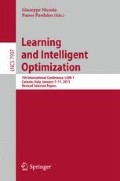Abstract
The prisoner’s dilemma is a two-player non-zero-sum game. Its iterated version has been frequently used to examine game strategy evolution in the literature. In this paper, we discuss the setting of neighborhood structures in its spatial iterated version. The main characteristic feature of our spatial iterated prisoner’s dilemma game model is that each cell has a different scheme to represent game strategies. In our computational experiments, one of four representation schemes is randomly assigned to each cell in a two-dimensional grid-world. An agent at each cell has a game strategy encoded by the assigned representation scheme. In this situation, an agent may have no neighbors with the same representation scheme as the agent’s scheme. The existence of such an agent has a negative effect on the evolution of cooperative behavior. This is because strategies with different representation schemes cannot be recombined. When no neighbors have the same representation scheme as the agent’s scheme, no recombination can be used for generating a new strategy for the agent. In our former study, we used a larger neighborhood structure for such an agent. As a result, each agent has a different neighborhood structure and a different number of neighbors. This makes it difficult to discuss the effect of the neighborhood size on the evolution of cooperative behavior. In this paper, we propose the use of the following setting: Each agent has the same number of neighbors with the same representation scheme as the agent’s scheme. This means that each agent has the same number of qualified neighbors as its mates. We also examine a different spatial model where the location of each agent is randomly specified as a point in a two-dimensional continuous space instead of a grid-world.
Access this chapter
Tax calculation will be finalised at checkout
Purchases are for personal use only
References
Ashlock, D., Kim, E.Y., Leahy, N.: Understanding representational sensitivity in the iterated prisoner’s dilemma with fingerprints. IEEE Trans. Syst. Man Cybern.: Part C 36, 464–475 (2006)
Ashlock, D., Kim, E.Y.: Fingerprinting: visualization and automatic analysis of prisoner’s dilemma strategies. IEEE Trans. Evol. Comput. 12, 647–659 (2008)
Ashlock, D., Kim, E.Y., Ashlock, W.: Fingerprint analysis of the noisy prisoner’s dilemma using a finite-state representation. IEEE Trans. Comput. Intell. AI Games 1, 154–167 (2009)
Ishibuchi, H., Ohyanagi, H., Nojima, Y.: Evolution of strategies with different representation schemes in a spatial iterated prisoner’s dilemma game. IEEE Trans. Comput. Intell. AI Games 3, 67–82 (2011)
Skolicki, Z., De Jong, K.A.: Improving evolutionary algorithms with multi-representation island models. In: Yao, X., Burke, E.K., Lozano, J., Smith, J., Merelo-Guervós, J., Bullinaria, J.A., Rowe, J.E., Tiňo, P., Kabán, A., Schwefel, H.-P. (eds.) PPSN 2004. LNCS, vol. 3242, pp. 420–429. Springer, Heidelberg (2004)
Oliphant, M.: Evolving cooperation in the non-iterated prisoner’s dilemma: the importance of spatial organization. In: Brooks, R.A., Maes. P. (eds.) Artificial Life IV, pp. 349–352 (1994)
Grim, P.: Spatialization and greater generosity in the stochastic prisoner’s dilemma. BioSystems 37, 3–17 (1996)
Brauchli, K., Killingback, T., Doebeli, M.: Evolution of cooperation in spatially structured populations. J. Theor. Biol. 200, 405–417 (1999)
Seo, Y.G., Cho, S.B., Yao, X.: The impact of payoff function and local interaction on the N-player iterated prisoner’s dilemma. Knowl. Inf. Syst. 2, 461–478 (2000)
Ishibuchi, H., Namikawa, N.: Evolution of iterated prisoner’s dilemma game strategies in structured demes under random pairing in game playing. IEEE Trans. Evol. Comput. 9, 552–561 (2005)
Ishibuchi, H., Hoshino, K., Nojima, Y.: Evolution of strategies in a spatial IPD game with a number of different representation schemes. In: Proceedings of 2012 IEEE Congress on Evolutionary Computation, pp. 808–815 (2012)
Ishibuchi, H., Hoshino, K., Nojima, Y.: Strategy evolution in a spatial IPD game where each agent is not allowed to play against itself. In: Proceedings of 2012 IEEE Congress on Evolutionary Computation, pp. 688–695 (2012)
Eshelman, L.J., Schaffer, J.D.: Real-coded genetic algorithms and interval-schemata. Foundations of Genetic Algorithms 2, pp. 187–202. Morgan Kaufman, San Mateo (1993)
Author information
Authors and Affiliations
Corresponding author
Editor information
Editors and Affiliations
Rights and permissions
Copyright information
© 2013 Springer-Verlag Berlin Heidelberg
About this paper
Cite this paper
Ishibuchi, H., Hoshino, K., Nojima, Y. (2013). Neighborhood Specification for Game Strategy Evolution in a Spatial Iterated Prisoner’s Dilemma Game. In: Nicosia, G., Pardalos, P. (eds) Learning and Intelligent Optimization. LION 2013. Lecture Notes in Computer Science(), vol 7997. Springer, Berlin, Heidelberg. https://doi.org/10.1007/978-3-642-44973-4_23
Download citation
DOI: https://doi.org/10.1007/978-3-642-44973-4_23
Published:
Publisher Name: Springer, Berlin, Heidelberg
Print ISBN: 978-3-642-44972-7
Online ISBN: 978-3-642-44973-4
eBook Packages: Computer ScienceComputer Science (R0)

